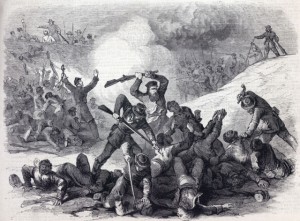The Confederate Army attacked Fort Pillow in Lauderdale County, Tennessee on April 12, 1864 in a fight that later became known as the Fort Pillow Massacre since the lives of few Union soldiers were spared. The National Park Service’s website gives a valuable overview of the fight and its commanding figures in its battle summaries section as well as a map that outlines the territory covered under the website’s Civil War Sites Advisory Commission Report Update and Resurvey. There is also a concise overview of African American Participation in the Civil War located on the website. Led by Major General Nathan Bedford Forrest, Confederate forces attacked Fort Pillow which was protected by 295 white Tennessee troops and 262 United States Colored Troops. Union Army Major Lionel F. Booth was killed during the battle and command was subsequently taken over by Major William F. Bradford. The atrocities committed by the Confederates were best described by The Rebellion Record:
“Then followed a scene of cruelty and murder without parallel in civilized warfare, which needed but the tomahawk and scalping- knife to exceed the worst atrocities over committed by savages. The rebels commenced an indiscriminate slaughter, neither sparing age nor sex, white nor black, civilian or soldier. The officers and men seemed to vie with each other in the devilish work; men, women, and even children, wherever found, were deliberately shot down, beaten, and hacked with sabres; some of the children not more than ten years old were forced to stand up and face their murderers while being shot; the sick and the wounded were butchered without mercy, the rebels even entering the hospital building and dragging them out to be shot or killing them as they lay there unable to offer the least resistance.”
Some other sources that may be valuable to further research on Fort Pillow and can be accessed through Google Books are The War of the Rebellion: A Compilation of the Official Records of Union and Confederate Armies as it gives mention of activity at the fort prior to the attack and A History of the Negro Troops in the War of the Rebellion, 1861-1865: Preceded by a Review of the Military Services of Negroes in Ancient and Modern Times which gives an interesting account of the scene at Fort Pillow through the eyes of an African-American soldier. In terms of modern scholarship, John Cimprich’s Fort Pillow, a Civil War Massacre and Public Memory provides valuable maps which could help gain a better understanding of the area surrounding the fort.









Related Articles
No user responded in this post
Leave A Reply
Please Note: Comment moderation maybe active so there is no need to resubmit your comments